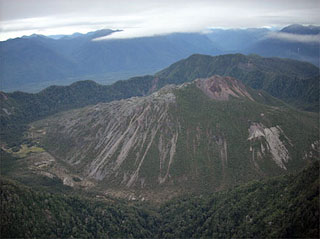Report on Chaiten (Chile) — 13 August-19 August 2008
Smithsonian Institution / US Geological Survey
Weekly Volcanic Activity Report, 13 August-19 August 2008
Managing Editor: Sally Sennert.
Please cite this report as:
Global Volcanism Program, 2008. Report on Chaiten (Chile) (Sennert, S, ed.). Weekly Volcanic Activity Report, 13 August-19 August 2008. Smithsonian Institution and US Geological Survey.
Chaiten
Chile
42.8349°S, 72.6514°W; summit elev. 1122 m
All times are local (unless otherwise noted)
SERNAGEOMIN reported that continuous emissions of gas-and-ash plumes from Chaitén were observed on 13 August, after three days of bad weather prevented visual observations. Plumes rose to an altitude of 2 km (6,600 ft) a.s.l., but later that day rose to greater altitudes of 6-7 km (19,700-23,000 ft) a.s.l. The increased activity did not correspond to any significant variation in seismicity. Plumes were emitted from two areas on the E and S flanks and were different colors; the area on the E flank produced steam plumes with minor ash content and the area on the S flank emitted darker ash plumes. The plumes drifted SW and caused ashfall in Chaitén town for several hours. The ash accumulation was 1.5 cm thick.
Based on web camera views, SIGMET reports, analysis of satellite imagery, and information from the Puerto Montt Flight Information Region (FIR), the Buenos Aires VAAC reported that during 16 and 18-19 August ash plumes rose to altitudes of 1.4-2.4 km (4,500-8,000 ft) a.s.l. and drifted NE, E, and SE.
Geological Summary. Chaitén is a small caldera (~3 km in diameter) located 10 km NE of the town of Chaitén on the Gulf of Corcovado. Multiple explosive eruptions throughout the Holocene have been identified. A rhyolitic obsidian lava dome occupies much of the caldera floor. Obsidian cobbles from this dome found in the Blanco River are the source of artifacts from archaeological sites along the Pacific coast as far as 400 km from the volcano to the N and S. The caldera is breached on the SW side by a river that drains to the bay of Chaitén. The first recorded eruption, beginning in 2008, produced major rhyolitic explosive activity and building a new dome and tephra cone on the older rhyolite dome.
Sources: Buenos Aires Volcanic Ash Advisory Center (VAAC), Servicio Nacional de Geología y Minería (SERNAGEOMIN)

